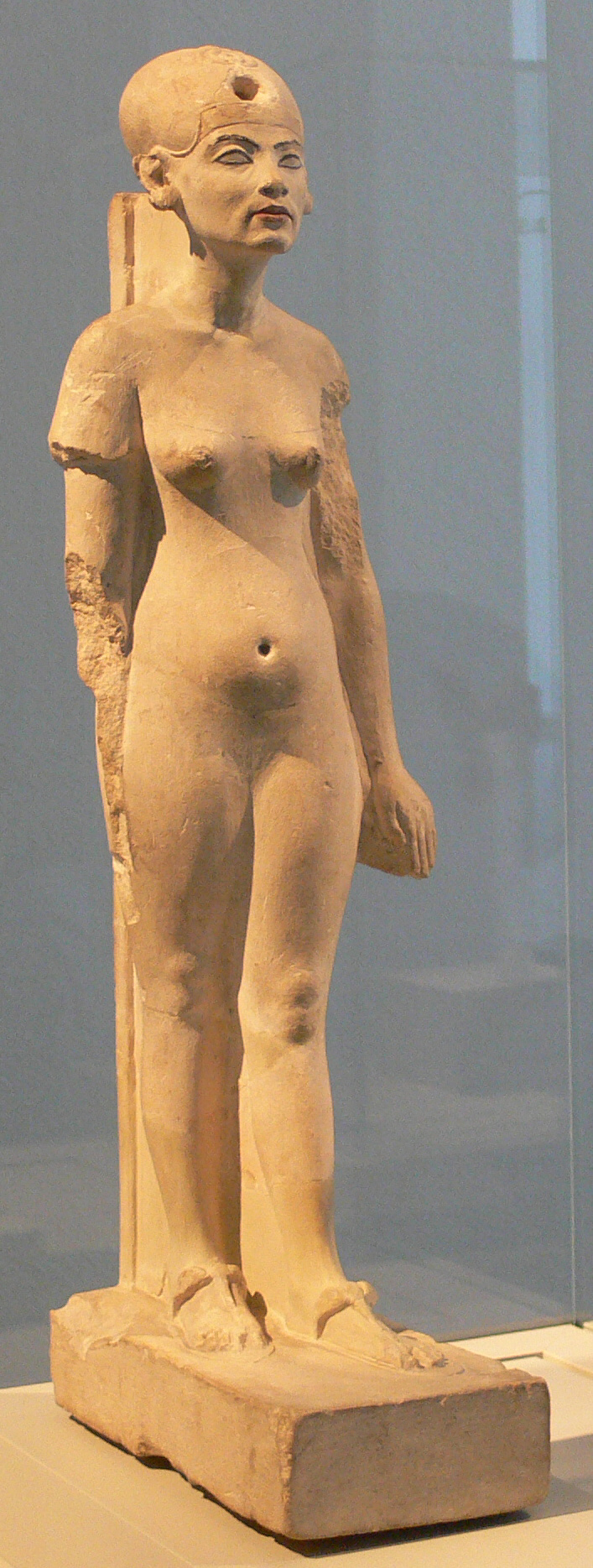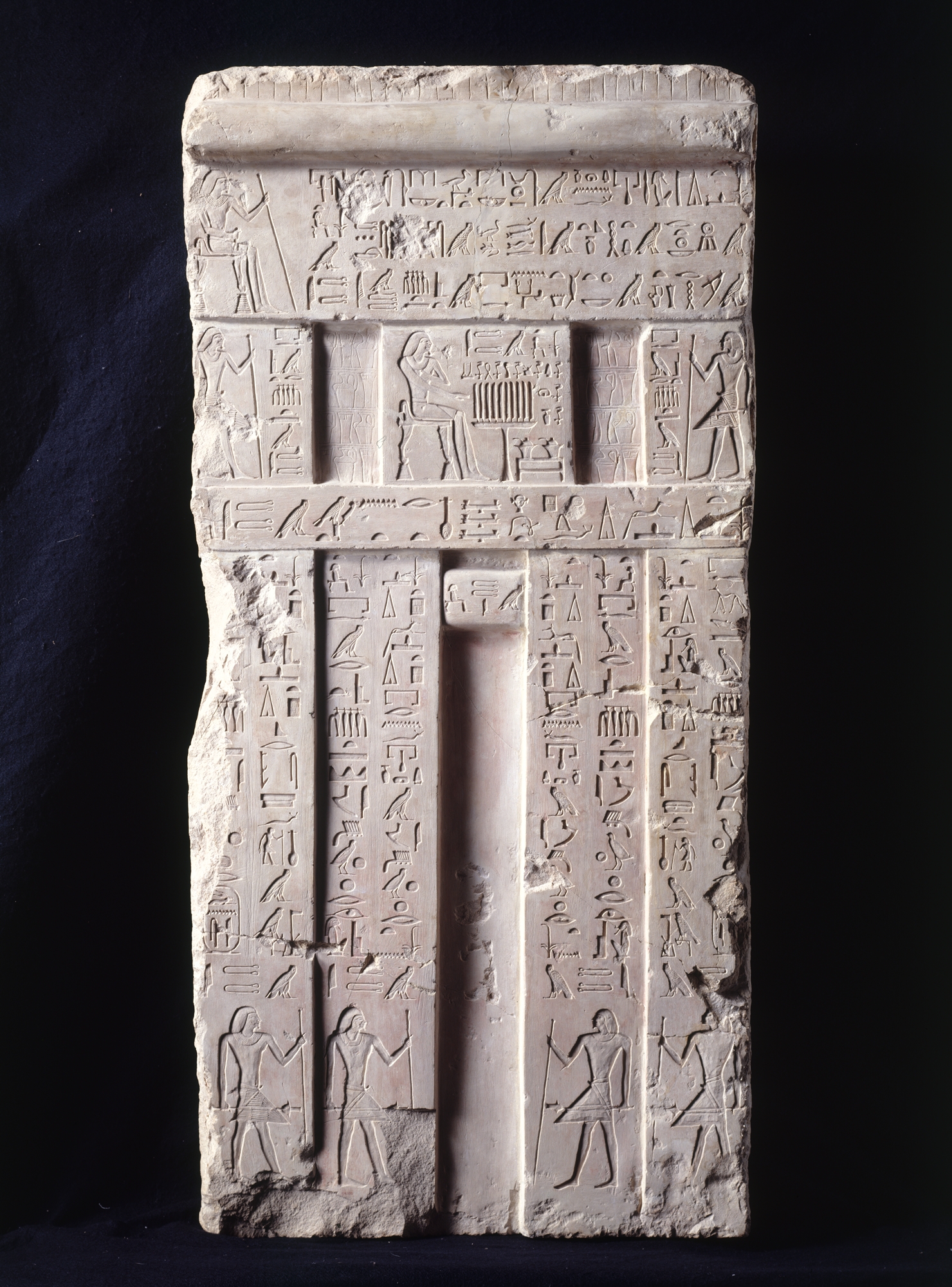|
Nefer
The Egyptian hieroglyph serves as a phonogram representing the triliteral consonant sequence ', and appears in Gardiner's sign list as number F35. It appears in the Egyptian word for "perfect, complete" (with the extended meanings of "good, pleasant, well, beautiful"), which has a reconstructed pronunciation of according to Loprieno. The hieroglyph has a conventional Egyptological vocalization of '. Form and appearance The triliteral Egyptian hieroglyph F35 ('nfr') has sometimes been explained as a representation of a lute; however, Egyptologists today no longer consider this hypothesis likely. Rather than a lute, the hieroglyph is actually a representation of the heart and trachea. It originally may have been the esophagus and heart. The striations of the windpipe only appear in the hieroglyph following the Old Kingdom of Egypt. The lower part of the sign has always clearly been the heart, for the markings clearly follow the form of a sheep's heart. Image:Nefertiabet ... [...More Info...] [...Related Items...] OR: [Wikipedia] [Google] [Baidu] |
Nefertiti
Nefertiti () () was a queen of the Eighteenth Dynasty of Egypt, 18th Dynasty of Ancient Egypt, the Great Royal Wife, great royal wife of Pharaoh Akhenaten. Nefertiti and her husband were known for their radical overhaul of state religious policy, in which they promoted the earliest known form of monotheism, Atenism, centered on Aten, the sun disc and its direct connection to the royal household. With her husband, she reigned at what was arguably the wealthiest period of ancient Egyptian history. After her husband's death, some scholars believe that Nefertiti ruled briefly as the female pharaoh known by the throne name, Neferneferuaten and before the ascension of Tutankhamun, although this identification is Neferneferuaten#Nefertiti, a matter of ongoing debate. If Nefertiti did rule as pharaoh, her reign was marked by the fall of Amarna and relocation of the capital back to the traditional city of Thebes, Egypt, Thebes. In the 20th century, Nefertiti was made famous by the disco ... [...More Info...] [...Related Items...] OR: [Wikipedia] [Google] [Baidu] |
Neferhotep I
Khasekhemre Neferhotep I was an Ancient Egypt, Egyptian pharaoh of the mid Thirteenth dynasty of Egypt, Thirteenth Dynasty ruling in the second half of the 18th century BCKim Ryholt, Ryholt, K.S.B: The Political Situation in Egypt During the Second Intermediate Period, c.1800–1550 BC', Carsten Niebuhr Institute Publications, 20. Copenhagen: Museum Tusculanum Press, (1997). . . . during a time referred to as the late Middle Kingdom of Egypt, Middle Kingdom or early Second Intermediate Period, depending on the scholar. One of the best attested rulers of the 13th Dynasty, Neferhotep I reigned for 11 years according to the Turin King List. The grandson of a non-royal townsman from a Thebes, Egypt, Theban family with a military background, Neferhotep I's relation to his predecessor Sobekhotep III is unclear and he may have usurped the throne. Neferhotep I was likely contemporaneous with kings Zimri-Lim of Mari, Syria, Mari and Hammurabi of Babylon. Little is known of his activities ... [...More Info...] [...Related Items...] OR: [Wikipedia] [Google] [Baidu] |
Nefertari
Nefertari, also known as Nefertari Meritmut, was an Egyptian queen and the first of the Great Royal Wife, Great Royal Wives (or principal wives) of Ramesses II, Ramesses the Great. She is one of the best known Egyptian queens, among such women as Cleopatra VII, Cleopatra, Nefertiti, and Hatshepsut, and one of the most prominent not known or thought to have queen regnant, reigned in her own right. She was highly educated and able to both read and write hieroglyphs, a very rare skill at the time. She used these skills in her diplomatic work, corresponding with other prominent royals of the time. Her lavishly decorated tomb, QV66, is one of the largest and most spectacular in the Valley of the Queens. Ramesses also constructed a temple for her at Abu Simbel next to his colossal monument there. Translation of name There are different interpretations of the meaning of the name Nefertari. Nefertari means 'beautiful companion' and Meritmut means 'Beloved of the goddess Mut'. Some sour ... [...More Info...] [...Related Items...] OR: [Wikipedia] [Google] [Baidu] |
Unas
Unas or Wenis, also spelled Unis (, Hellenization, hellenized form Oenas or Onnos; died 2345), was a pharaoh, king, the ninth and last ruler of the Fifth Dynasty of Egypt during the Old Kingdom of Egypt, Old Kingdom. Unas reigned for 15 to 30 years in the mid-24th century BC (c. 2345–2315 BC), succeeding Djedkare Isesi, who might have been his father. Little is known of Unas' activities during his reign, which was a time of economic decline. Egypt maintained trade relations with the Levantine coast and Nubia, and military action may have taken place in southern Canaan. The growth and decentralization of the administration in conjunction with the lessening of the king's power continued under Unas, ultimately contributing to the collapse of the Old Kingdom some 200 years later. Unas built a Pyramid of Unas, pyramid in Saqqara, the smallest of the royal Egyptian pyramids, pyramids completed during the Old Kingdom. The accompanying mortuary complex with its high and valley tem ... [...More Info...] [...Related Items...] OR: [Wikipedia] [Google] [Baidu] |
Old Kingdom Of Egypt
In ancient Egyptian history, the Old Kingdom is the period spanning –2200 BC. It is also known as the "Age of the Pyramids" or the "Age of the Pyramid Builders", as it encompasses the reigns of the great pyramid-builders of the Fourth Dynasty of Egypt, Fourth Dynasty, such as King Sneferu, under whom the art of pyramid-building was perfected, and the kings Khufu, Khafre and Menkaure, who commissioned the construction of the Giza pyramid complex, pyramids at Giza. Ancient Egypt, Egypt attained its first sustained peak of civilization during the Old Kingdom, the first of three so-called "Kingdom" Egyptian chronology, periods (followed by the Middle Kingdom of Egypt, Middle Kingdom and New Kingdom of Egypt, New Kingdom), which mark the high points of civilization in the lower Nile Valley. The Periodization of Ancient Egypt, concept of an "Old Kingdom" as one of three "golden ages" was coined in 1845 by the German Egyptology, Egyptologist Christian Charles Josias von Bunsen, Baron ... [...More Info...] [...Related Items...] OR: [Wikipedia] [Google] [Baidu] |
Eleventh Dynasty Of Egypt
The Eleventh Dynasty of ancient Egypt (notated Dynasty XI; ) is a well-attested group of rulers. Its earlier members before Pharaoh Mentuhotep II are grouped with the four preceding dynasty, dynasties to form the First Intermediate Period, whereas the later members are considered part of the Middle Kingdom of Egypt, Middle Kingdom. They all ruled from Thebes (Egypt), Thebes in Upper Egypt. Characteristics The relative chronology of the 11th Dynasty is well established by contemporary attestations and, except for count Intef and Mentuhotep IV, by the Turin King List, Turin canon.mirror Manetho's statement that the 11th Dynasty consisted of 16 kings, who reigned for 43 years is contradicted by contemporary inscriptions and the evidence of the Turin King List, whose combined testimony establishes that this kingdom consisted of seven kings who ruled for a total of 143 years. However, his testimony that this dynasty was based at Thebes, Egypt, Thebes is verified by the contemporary ev ... [...More Info...] [...Related Items...] OR: [Wikipedia] [Google] [Baidu] |
Beauty
Beauty is commonly described as a feature of objects that makes them pleasure, pleasurable to perceive. Such objects include landscapes, sunsets, humans and works of art. Beauty, art and taste are the main subjects of aesthetics, one of the fields of study within philosophy. As a positive aesthetic value, it is contrasted with Unattractiveness, ugliness as its negative counterpart. One difficulty in understanding beauty is that it has both objective and subjective aspects: it is seen as a property of things but also as depending on the emotional response of observers. Because of its subjective side, beauty is said to be "in the eye of the beholder". It has been argued that the ability on the side of the subject needed to perceive and judge beauty, sometimes referred to as the "sense of taste", can be trained and that the verdicts of experts coincide in the long run. This suggests the standards of validity of judgments of beauty are intersubjective, i.e. dependent on a group of j ... [...More Info...] [...Related Items...] OR: [Wikipedia] [Google] [Baidu] |
Tenth Dynasty Of Egypt
The Tenth Dynasty of ancient Egypt (Dynasty X) is often combined with the Seventh Dynasty of Egypt, 7th, Eighth Dynasty of Egypt, 8th, Ninth Dynasty of Egypt, 9th and early Eleventh Dynasty of Egypt, 11th Dynasties under the group title First Intermediate Period. Rulers The 9th Dynasty was founded at Herakleopolis Magna, and the 10th Dynasty continued there. At this time Egypt was not unified, and there is some overlap between these and other local dynasties. The Turin Canon lists eighteen kings for this royal line, but their names are damaged, unidentifiable, or lost.Sir Alan Gardiner, ''Egypt of the Pharaohs'', Oxford University Press, 1961, pp. 112-13. The following is a ''possible'' list of rulers of the Tenth Dynasty based on the Turin Canon, as Egyptologists have differing opinions about the order of succession within the two dynasties. Among them, only Wahkare Khety and Merykare are undoubtedly attested by archaeological finds: References Tenth Dynast ... [...More Info...] [...Related Items...] OR: [Wikipedia] [Google] [Baidu] |
Demotic (Egyptian)
Demotic (from ''dēmotikós'', 'popular') is the ancient Egyptian script derived from northern forms of hieratic used in the Nile Delta. The term was first used by the Greek historian Herodotus to distinguish it from hieratic and Egyptian hieroglyphs, hieroglyphic scripts. By convention, the word "Demotic" is capitalized in order to distinguish it from demotic Greek. Script The Demotic script was referred to by the Egyptians as 'document writing', which the second-century scholar Clement of Alexandria called 'letter-writing', while early Western scholars, notably Thomas Young (scientist), Thomas Young, formerly referred to it as "wikt:enchorial, Enchorial Egyptian". The script was used for more than a thousand years, and during that time a number of developmental stages occurred. It is written and read from right to left, while earlier hieroglyphs could be written from top to bottom, left to right, or right to left. Parts of the Demotic Greek Magical Papyri were written with a ... [...More Info...] [...Related Items...] OR: [Wikipedia] [Google] [Baidu] |
Adolf Erman
Johann Peter Adolf Erman (; 31 October 185426 June 1937) was a German Egyptologist and lexicographer. Education Born in Berlin, he was the son of the physicist Georg Adolf Erman and grandson of the physicist Paul Erman and the astronomer Friedrich Wilhelm Bessel. Educated at Leipzig and Berlin, he became associate professor of Egyptology at the University of Berlin in 1883 and full professor in 1892. In 1885 he was appointed director of the Egyptian department at the royal museum. In 1934 he was excluded from the faculty of the university because he was, according to the Nazi ideology, one quarter Jewish. As his family had converted to Protestantism in 1902, he and his family were not persecuted by the Nazi Party, but they all lost their positions. Career Erman and his school at Berlin had the difficult task of recovering the grammar of the Egyptian language and spent thirty years of special study on it. The greater part of Egyptian texts after the Middle Kingdom having been ... [...More Info...] [...Related Items...] OR: [Wikipedia] [Google] [Baidu] |








